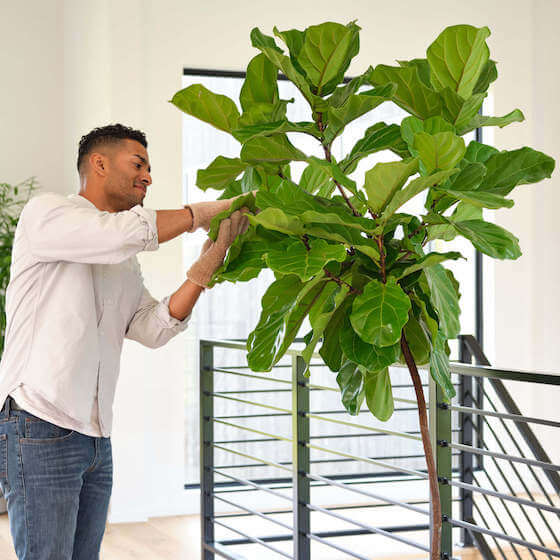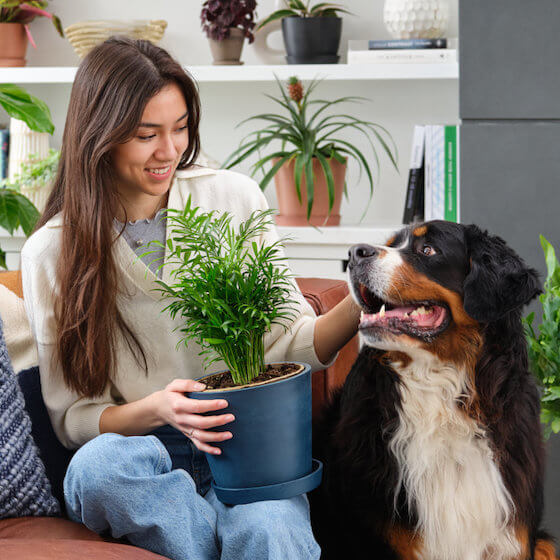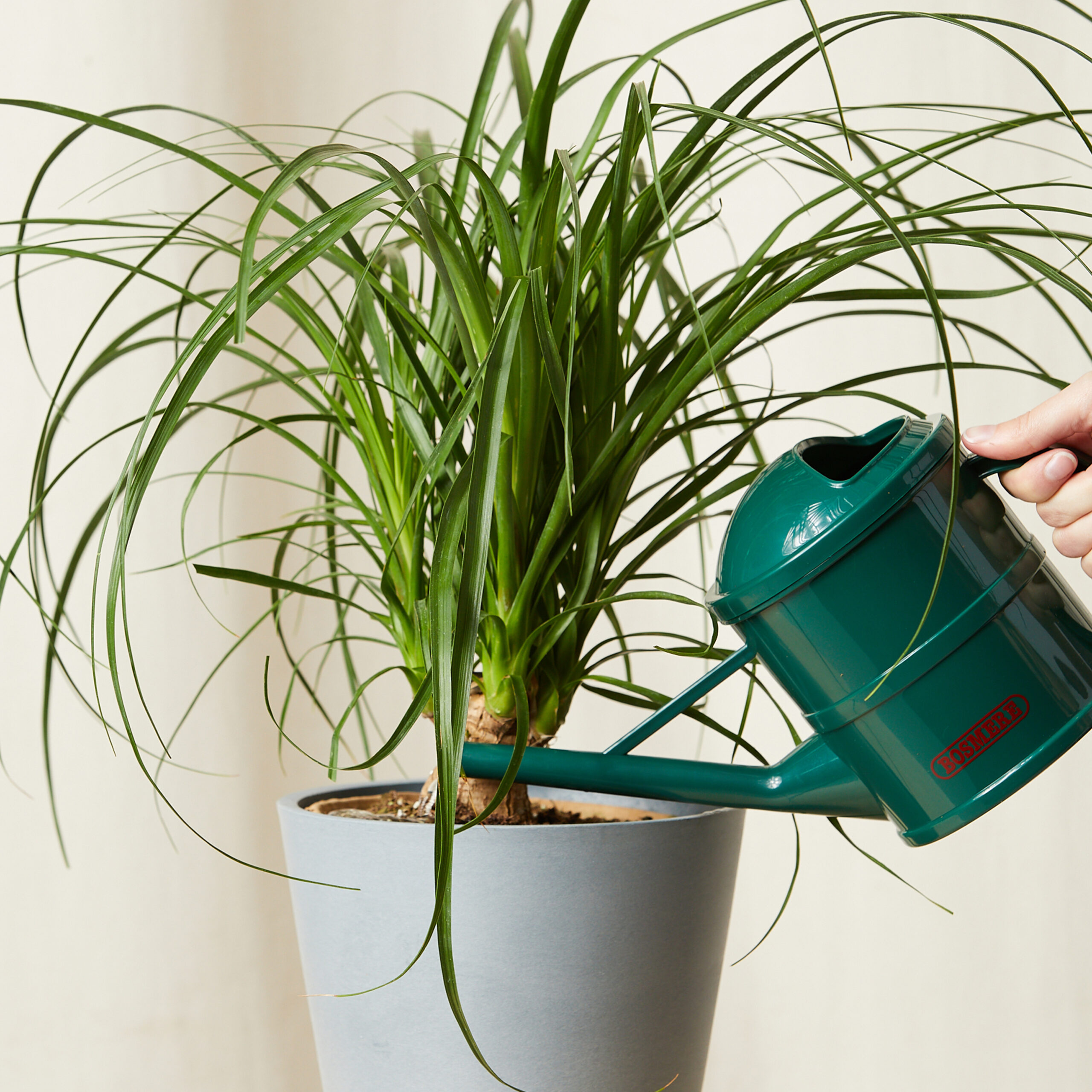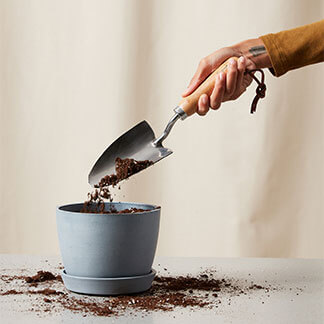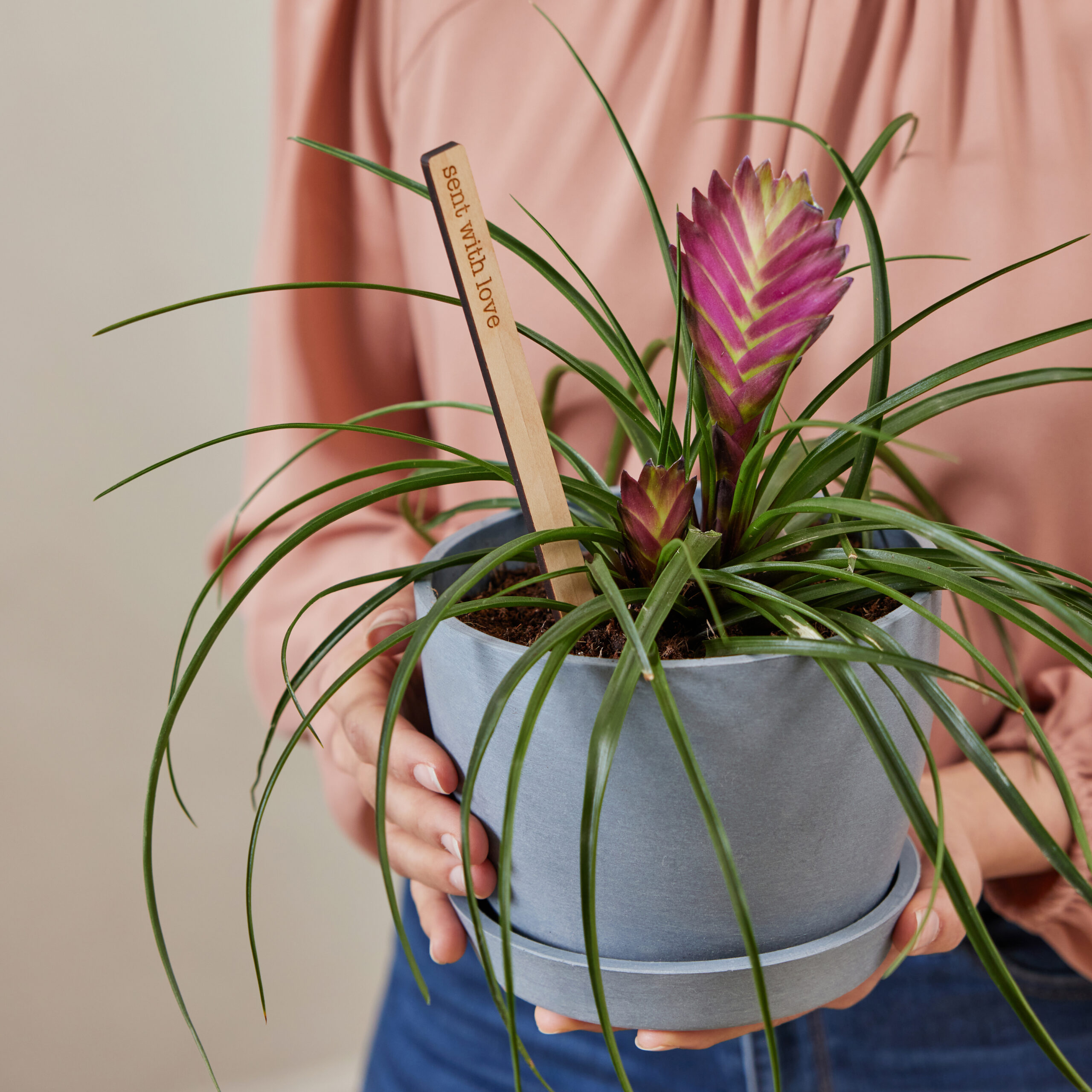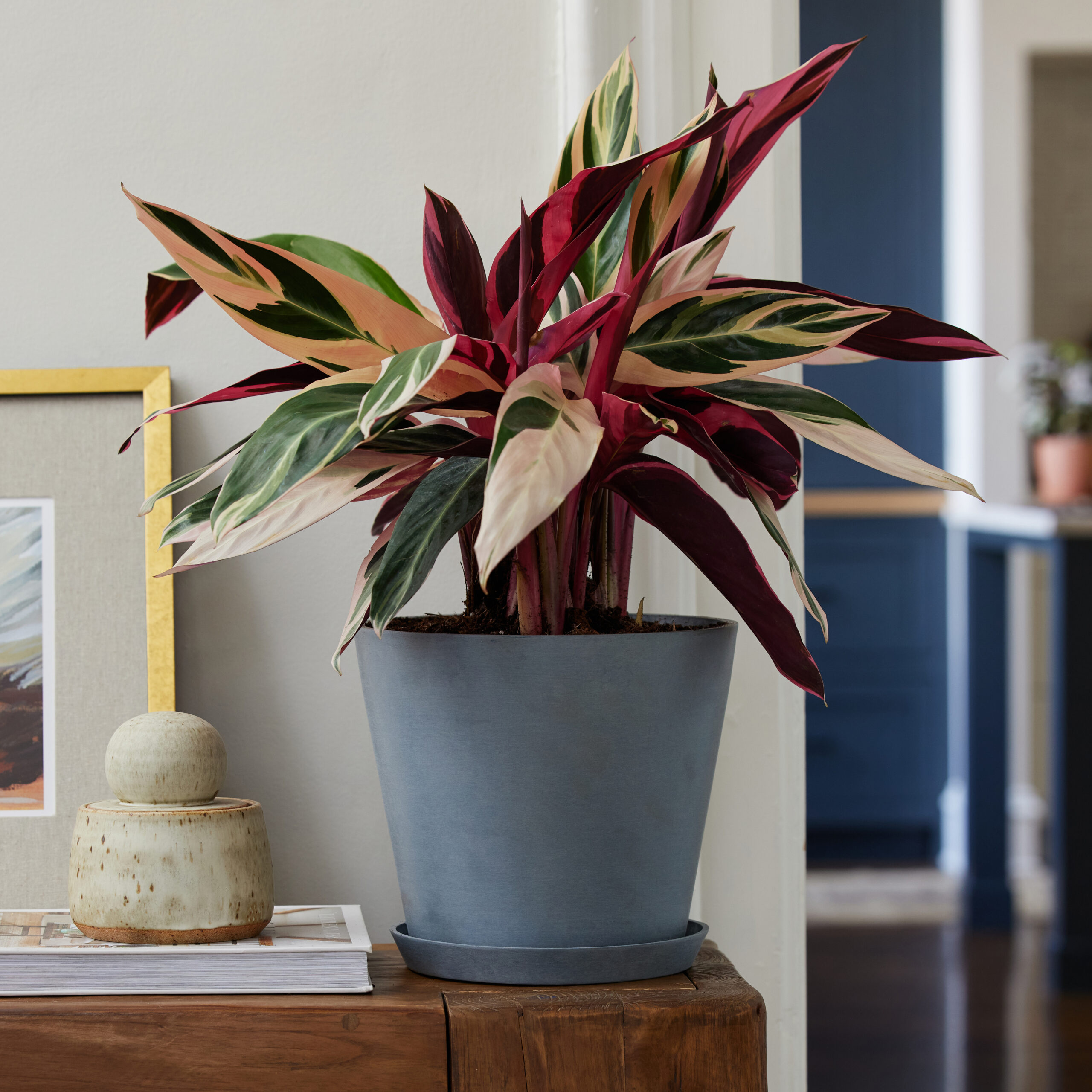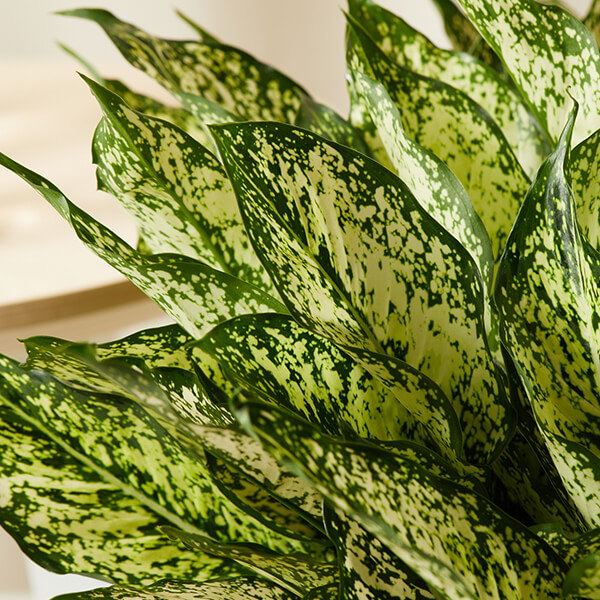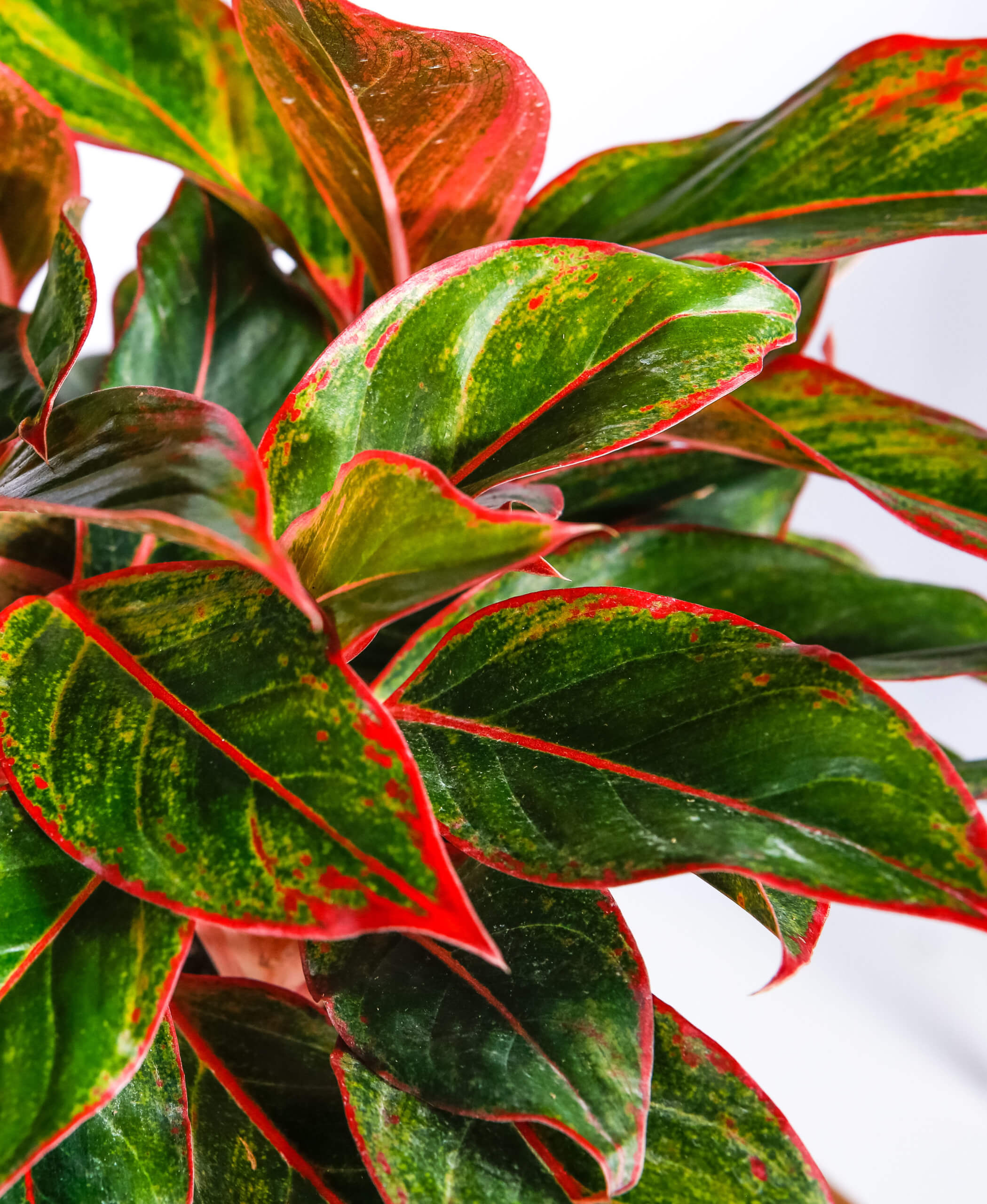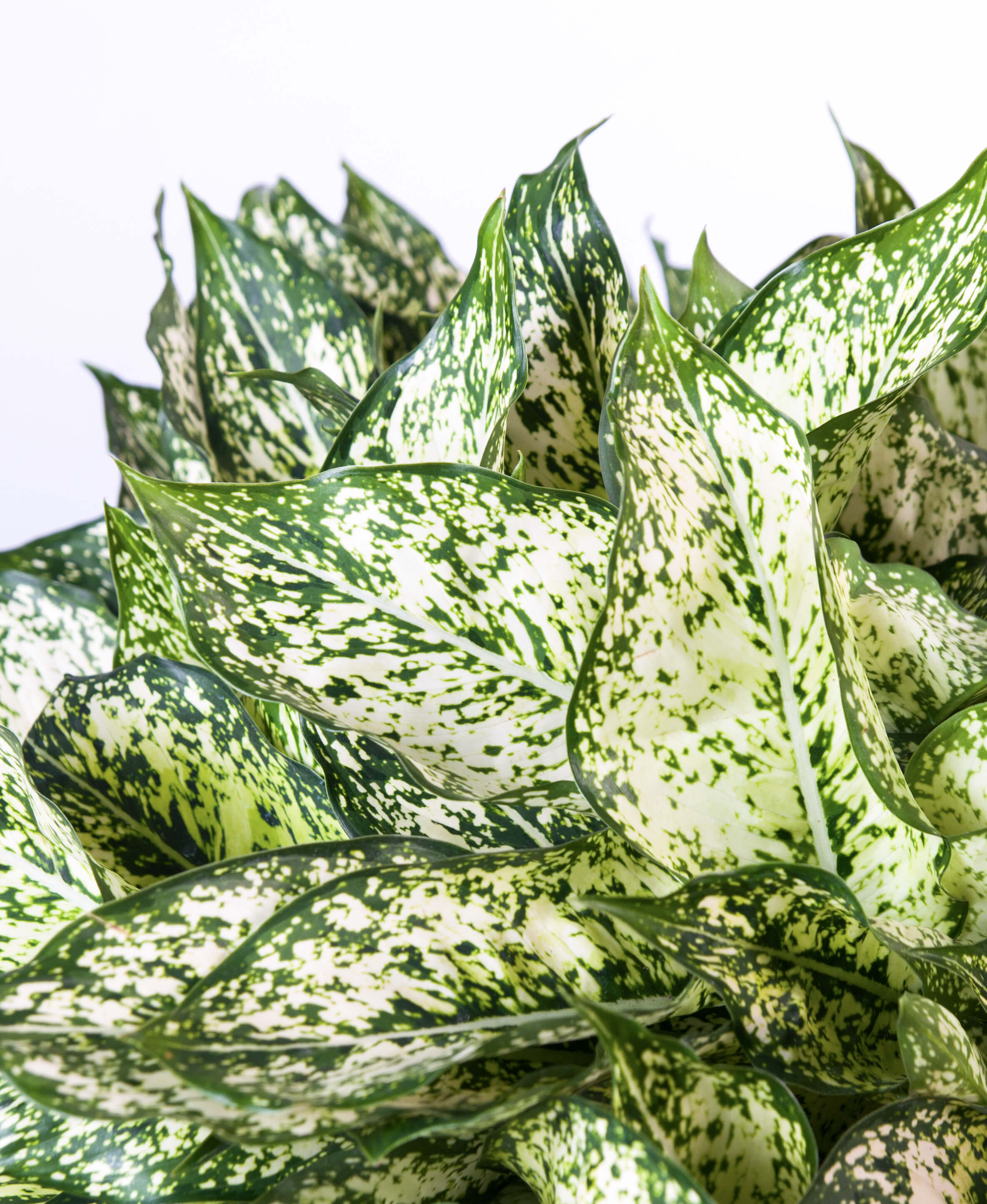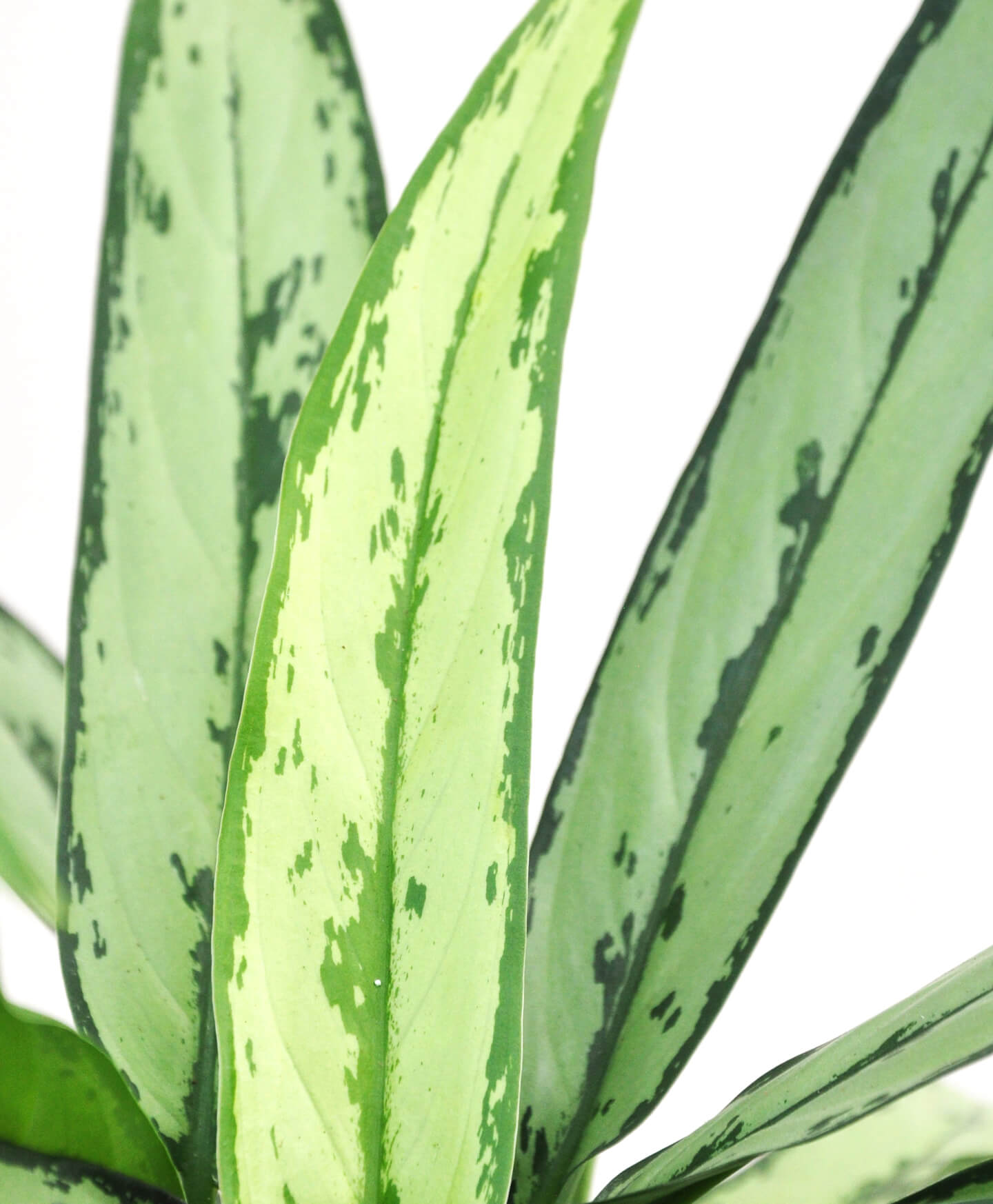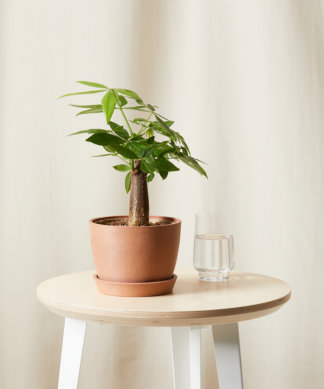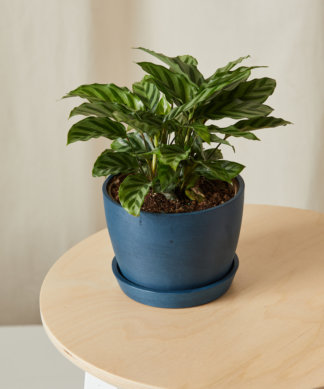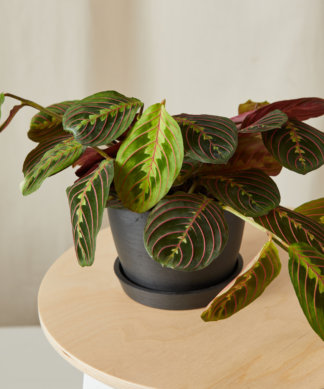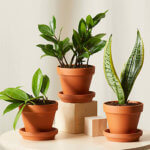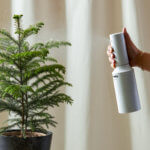How to care for your Aglaonema
Use these instructions to care for an Aglaonema. This guide will tell you how to water an Aglaonema; its light, temperature, humidity preferences and any additional care it might need to help it grow.
Aglaonema Red Vein
Your Aglaonema prefers bright to medium indirect light, but can also adapt to low light. Prolonged exposure to direct light can burn the leaves. If you notice the coloration fading on your Aglaonema, try placing the plant in a brighter location with indirect light.
Water your Aglaonema when 50% of the soil volume is dry. Water slowly, allowing it to soak into the soil, until liquid flows through the drainage hole at the bottom of the pot. Discard any water that has accumulated in the saucer.
Your Agaonema does well in average household humidity. However, if the air is very dry, it will appreciate the occasional humidity boost using a pebble tray or humidifier.
Your Aglaonema prefers temperatures between 65-75°F. Avoid drafty areas and temperatures below 60°F.
Feed your Aglaonema monthly during the spring and summer months with a general-purpose houseplant fertilizer diluted to half strength. Feed once during the fall season. No fertilizer is needed during the winter months when growth naturally slows.
Your Aglaonema is toxic to humans and pets if ingested.
Aglaonema prefers to be slightly root-bound and will not need to be repotted more than once every 2-3 years. Keep their glossy leaves clean by dusting regularly, which also helps prevent pests.
Aglaonema Siam
Your Aglaonema prefers bright to medium indirect light. It can adapt to low light, but the growth will slow. Direct morning sunlight is fine for this plant, but avoid prolonged exposure to direct sun which can scorch the leaves.
Water your Aglaonema when 50% of the soil volume is dry. Water until liquid flows through the drainage hole at the bottom of the pot and discard any water that has accumulated in the saucer.
Your Aglaonema enjoys extra humidity. Use a pebble tray, place a humidifier nearby, or group plants together to create a humid microclimate.
Your Aglaonema prefers temperatures between 65-75°F. Avoid drafty areas and temperatures below 60°F in the winter.
Feed your Aglaonema monthly during the spring and summer months with a general-purpose houseplant fertilizer diluted to half strength. No fertilizer is needed during the winter months when growth naturally slows.
This plant is considered mildly toxic to pets and humans.
Aglaonema prefer to be slightly root-bound and will not need to be repotted more than once every 2-3 years. Choose a pot only about 1” bigger in diameter when repotting. If you notice the pink coloration fading on your Aglaonema, try placing the plant in a brighter location with indirect light.
Cutlass Aglaonema
By nature, Aglaonemas do best in well-lit locations such as a window sill with eastern light exposure. Bright, but indirect sunlight is optimal. Be careful not to put your Cutlass Aglaonema in full sun, as the leaves will burn. If you don’t have an ideal location for your Aglaonema, use a Grow Light. Your Cutlass Aglaonema will also tolerate, and even thrive in, low light areas. In most cases, artificial light found in windowless offices proves enough for this tough plant.
Water your Aglaonema when 50% of the soil volume is dry. Water until liquid flows through the drainage hole at the bottom of the pot and discard any water that has accumulated in the saucer.
This plant can survive in a low humidity environment, but it will thrive with a higher humidity level. Mist the leaves regularly using a Mister to raise the humidity.
Your Aglaonema prefers temperatures between 65–75°F. Avoid drafty areas and temperatures below 60°F in the winter.
Feed your Aglaonema monthly during the spring and summer months with a general-purpose houseplant fertilizer diluted to half strength such as our All Purpose Fertilizer (20-20-20). No fertilizer is needed during the winter months when growth naturally slows.
This plant is moderately toxic to pets and humans. Typically, ingestion will cause mouth and stomach irritation and possible vomiting.
A common problem with Aglaonema is called ‘tipping’ when the tips of the leaves dry out and turn brown. This can be caused by a variety of issues like overwatering, too much fertilizer, etc. The most common cause is tap water, which contains salts, chlorine, and fluoride. If you do not have a filtration system, leaving the tap water in an open container overnight before watering can help remove some of the chemicals. If your Aglaonema is in need of a trim, clean up your plant using clean, sharp Plant Snips.
Indo Princess Aglaonema
Your Indo Princess Aglaonema prefers indirect bright light. It can adapt to low light, but the growth will slow considerably. Direct morning sunlight is fine for this plant, but avoid direct afternoon sunlight which can burn the leaves. If you don’t have an ideal location for your Aglaonema, use a Grow Light. In low light, variegation will not be as pronounced.
Water your Aglaonema when 50% of the soil volume is dry. Water until liquid flows through the drainage hole at the bottom of the pot and discard any water that has accumulated in the saucer.
This plant can survive in a low humidity environment, but it will thrive with a higher humidity level. Mist the leaves regularly using a Mister to raise the humidity.
Your Aglaonema prefers temperatures between 65–75°F. Avoid drafty areas and temperatures below 60°F in the winter.
Feed your Aglaonema monthly during the spring and summer months with a general-purpose houseplant fertilizer diluted to half strength such as our All Purpose Fertilizer (20-20-20). No fertilizer is needed during the winter months when growth naturally slows.
Your Indo Princess is moderately toxic to pets and humans. Typically, ingestion will cause mouth and stomach irritation and possible vomiting.
A common problem with Aglaonema is called ‘tipping’ when the tips of the leaves dry out and turn brown. This can be caused by a variety of issues like overwatering, too much fertilizer, etc. The most common cause is tap water, which contains salts, chlorine, and fluoride. If you do not have a filtration system, leaving the tap water in an open container overnight before watering can help remove some of the chemicals. If your Aglaonema is in need of a trim, clean up your plant using clean, sharp Plant Snips.
Pink Aglaonema
Your Aglaonema prefers indirect bright light. It can adapt to low light, but the growth will slow considerably. Direct morning sunlight is fine for this plant, but avoid direct afternoon sunlight which can burn the leaves. If you don’t have an ideal location for your Aglaonema, use a Grow Light. If you notice the pink coloration fading on your Aglaonema, try placing the plant in a brighter location with indirect light.
Water your Aglaonema when 50% of the soil volume is dry. Water until liquid flows through the drainage hole at the bottom of the pot and discard any water that has accumulated in the saucer.
Your Aglaonema enjoys extra humidity. Mist the leaves regularly using a Mister, place a humidifier nearby, or use a pebble tray to raise the humidity.
Your Aglaonema prefers temperatures between 65–75°F. Avoid drafty areas and temperatures below 60°F in the winter.
Feed your Aglaonema monthly during the spring and summer months with a general-purpose houseplant fertilizer diluted to half strength such as our All Purpose Fertilizer (20-20-20). No fertilizer is needed during the winter months when growth naturally slows.
Your Aglaonema is mildly toxic to pets and humans. Typically, ingestion will cause mouth and stomach irritation and possible vomiting.
Aglaonema prefer to be slightly root-bound and will not need to be repotted more than once every 2-3 years. Choose a pot only about 2” bigger in diameter when repotting. If your Aglaonema is in need of a trim, clean up your plant using clean, sharp Plant Snips.
Pink Dalmatian Aglaonema
Bright indirect sunlight is optimal and will help your Pink Dalmatian Aglaonema produce the beautiful pink spots on its leaves. Be careful not to put it in full sun because, in many cases, the leaves will burn. If you don’t have an ideal location for your Aglaonema, use a Grow Light. This plant will tolerate low light areas but the leaf spots and variegation will not be as pronounced.
Water your Aglaonema when 50% of the soil volume is dry. Water until liquid flows through the drainage hole at the bottom of the pot and discard any water that has accumulated in the saucer.
This plant can survive in a low humidity environment, but it will thrive with a higher humidity level. Mist the leaves regularly using a Mister to raise the humidity.
Your Aglaonema prefers temperatures between 65–75°F. Avoid drafty areas and temperatures below 60°F in the winter.
Feed your Aglaonema monthly during the spring and summer months with a general-purpose houseplant fertilizer diluted to half strength such as our All Purpose Fertilizer (20-20-20). No fertilizer is needed during the winter months when growth naturally slows.
The Pink Dalmatian Aglaonema is moderately toxic to pets and humans. Typically, ingestion will cause mouth and stomach irritation and possible vomiting.
A common problem with Aglaonema is called ‘tipping’ when the tips of the leaves dry out and turn brown. This can be caused by a variety of issues like overwatering, too much fertilizer, etc. The most common cause is tap water, which contains salts, chlorine, and fluoride. If you do not have a filtration system, leaving the tap water in an open container overnight before watering can help remove some of the chemicals. If your Aglaonema is in need of a trim, clean up your plant using clean, sharp Plant Snips.
Pink Splash Aglaonema
Your Aglaonema prefers indirect bright light. It can adapt to low light, but the growth will slow considerably. Direct morning sunlight is fine for this plant, but avoid direct afternoon sunlight which can burn the leaves. If you don’t have an ideal location for your Aglaonema, use a Grow Light. If you notice the coloration fading on your Aglaonema, try placing the plant in a brighter location with indirect light.
Water your Aglaonema when 50% of the soil volume is dry. Water until liquid flows through the drainage hole at the bottom of the pot and discard any water that has accumulated in the saucer.
This plant can survive in a low humidity environment, but it will thrive with a higher humidity level. Mist the leaves regularly using a Mister to raise the humidity.
Your Aglaonema prefers temperatures between 65–75°F. Avoid drafty areas and temperatures below 60°F in the winter.
Feed your Aglaonema monthly during the spring and summer months with a general-purpose houseplant fertilizer diluted to half strength such as our All Purpose Fertilizer (20-20-20). No fertilizer is needed during the winter months when growth naturally slows.
The Pink Splash Aglaonema is moderately toxic to pets and humans. Typically, ingestion will cause mouth and stomach irritation and possible vomiting.
A common problem with Aglaonema is called ‘tipping’ when the tips of the leaves dry out and turn brown. This can be caused by a variety of issues like overwatering, too much fertilizer, etc. The most common cause is tap water, which contains salts, chlorine, and fluoride. If you do not have a filtration system, leaving the tap water in an open container overnight before watering can help remove some of the chemicals. If your Aglaonema is in need of a trim, clean up your plant using clean, sharp Plant Snips.
Red Aglaonema
Your Aglaonema prefers indirect bright light. It can adapt to low light, but the growth will slow considerably. Direct morning sunlight is fine for this plant, but avoid direct afternoon sunlight which can burn the leaves. If you don’t have an ideal location for your Aglaonema, use a Grow Light. In low light, its color and variegation will not be as pronounced.
Water your Aglaonema when 50% of the soil volume is dry. Water until liquid flows through the drainage hole at the bottom of the pot and discard any water that has accumulated in the saucer.
This plant can survive in a low humidity environment, but it will thrive with higher humidity levels. Mist the leaves regularly using a Mister to raise the humidity, especially during the drier winter months.
Your Aglaonema prefers temperatures between 65–75°F. Avoid drafty areas and temperatures below 60°F in the winter.
Feed your Aglaonema monthly during the spring and summer months with a general-purpose houseplant fertilizer diluted to half strength such as our All Purpose Fertilizer (20-20-20). No fertilizer is needed during the winter months when growth naturally slows.
The Red Aglaonema is moderately toxic to pets and humans. Typically, ingestion will cause mouth and stomach irritation and possible vomiting.
A common problem with Aglaonema is called ‘tipping’ when the tips of the leaves dry out and turn brown. This can be caused by a variety of issues like overwatering, too much fertilizer, etc. The most common cause is tap water, which contains salts, chlorine, and fluoride. If you do not have a filtration system, leaving the tap water in an open container overnight before watering can help remove some of the chemicals. If your Aglaonema is in need of a trim, clean up your plant using clean, sharp Plant Snips.
Silver Bay Aglaonema
Your Aglaonema prefers bright to medium indirect light, but can also adapt to low light. Prolonged exposure to direct light can burn the leaves. If you notice the coloration fading on your Aglaonema, try placing the plant in a brighter location with indirect light. If you don’t have an ideal location for your Aglaonema, use a Grow Light. Your Silver Bay Aglaonema will also tolerate and even thrive, in low light areas. In most cases, artificial light found in windowless offices proves enough for this tough plant.
Water your Aglaonema when 50% of the soil volume is dry. Water until liquid flows through the drainage hole at the bottom of the pot and discard any water that has accumulated in the saucer.
This plant can survive in a low humidity environment, but it will thrive with a higher humidity level. Mist the leaves regularly using a Mister to raise the humidity.
Your Aglaonema prefers temperatures between 65–75°F. Avoid drafty areas and temperatures below 60°F in the winter.
Feed your Aglaonema monthly during the spring and summer months with a general-purpose houseplant fertilizer diluted to half strength such as our All Purpose Fertilizer (20-20-20). No fertilizer is needed during the winter months when growth naturally slows.
Your Aglaonema is moderately toxic to pets and humans. Typically, ingestion will cause mouth and stomach irritation and possible vomiting.
Aglaonema prefers to be slightly root-bound and will not need to be repotted more than once every 2-3 years. Choose a pot about 2” bigger in diameter when repotting. If your Aglaonema is in need of a trim, clean up your plant using clean, sharp Plant Snips.
Spring Snow Aglaonema
Your Aglaonema prefers indirect bright light. It can adapt to low light, but the growth will slow considerably. Direct morning sunlight is fine for this plant, but avoid direct afternoon sunlight which can burn the leaves. If you don’t have an ideal location for your Aglaonema, use a Grow Light. In low light, variegation will not be as pronounced.
Water your Aglaonema when 50% of the soil volume is dry. Water until liquid flows through the drainage hole at the bottom of the pot and discard any water that has accumulated in the saucer.
Your Spring Snow Aglaonema can survive in a low humidity environment but will thrive with higher humidity levels. Mist the leaves regularly using a Mister, place a humidifier nearby, or use a pebble tray to raise the humidity.
Your Aglaonema prefers temperatures between 65–75°F. Avoid drafty areas and temperatures below 60°F in the winter.
Feed your Aglaonema monthly during the spring and summer months with a general-purpose houseplant fertilizer diluted to half strength such as our All Purpose Fertilizer (20-20-20). No fertilizer is needed during the winter months when growth naturally slows.
Your Spring Snow Aglaonema is moderately toxic to pets and humans. Typically, ingestion will cause mouth and stomach irritation and possible vomiting.
A common problem with Aglaonema is called ‘tipping’ when the tips of the leaves dry out and turn brown. This can be caused by a variety of issues like overwatering, too much fertilizer, etc. The most common cause is tap water, which contains salts, chlorine, and fluoride. If you do not have a filtration system, leaving the tap water in an open container overnight before watering can help remove some of the chemicals. If your Aglaonema is in need of a trim, clean up your plant using clean, sharp Plant Snips.
